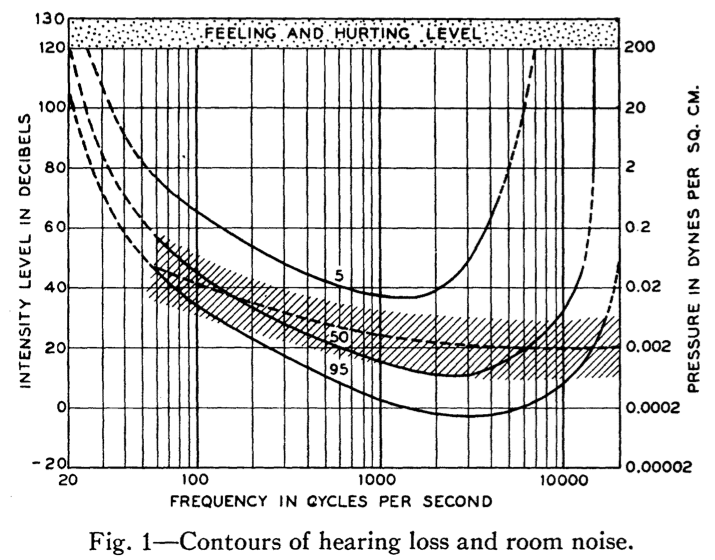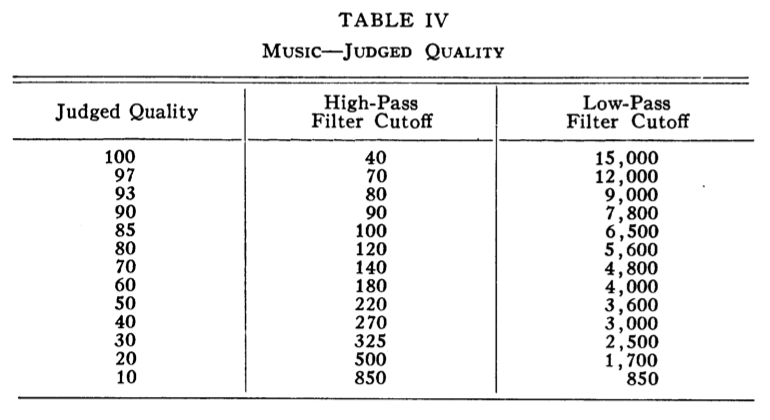There is an ongoing debate in audio circles about just how much frequency response is really required from an audio system. Different systems for different uses may have vastly different requirements. The audio response required for a media room amplifier where various sound effects, explosions, noises, as such must be accurately reproduced may be far different that that required for orchestral music or jazz listening in a study or living room. So the pertinent question becomes, “For what conditions do we design?”.
There are those that insist that the gold standard is flat response from 20Hz to 20kHz and nothing else will do. But is this really true? Recently I was doing some reading on this subject and rediscovered a paper written by Harvey Fletcher of Bell Labs for the technical journal Proceedings of the I.R.E. published in June of 1942. The paper, titled “Hearing, the Determining Factor for High-Fidelity Transmission”, discusses the requirements for systems for the transmission of speech and music. The interesting part about this paper is it address the issue firstly from the perspective of human hearing and perception. The paper uses the results of a massive participation study conducted during the New York and San Francisco World’s Fairs and includes the responses of approximately 500,000 people.
The paper contains a wealth of good information on hearing, frequencies, and music and speech reproduction , however I would like to highlight two distinct findings from the paper. The first is the statistical data for hearing threshold levels for the entire sample population by frequency. Consider this figure from the paper.
 The lines in this figure show the hearing minimum hearing threshold by frequency, from 20Hz to 20KHz, for the 5th, 50th, and 95th percentile populations sampled. The 5th percentile could be considered the poorest hearing portion of the population with worse hearing than the other 95% of the population. Not only does this population require much louder sounds to be heard over most of the frequency band, their hearing becomes very poor outside of the frequencies from about 55Hz to 5000Hz. The 50th percentile could be considered to be the “average” of the population. The hearing of this population is considerably better than the 5th percentile group but it is still limited. The average hearing becomes relatively poor outside of the band from about 34Hz to 15kHz. The 95th percentile is could be considered the very best of the hearing population. Their hearing is better than 95% of the people sampled. But even with this group, their hearing becomes limited below about 28Hz but does extend all the way to 20kHz.
The lines in this figure show the hearing minimum hearing threshold by frequency, from 20Hz to 20KHz, for the 5th, 50th, and 95th percentile populations sampled. The 5th percentile could be considered the poorest hearing portion of the population with worse hearing than the other 95% of the population. Not only does this population require much louder sounds to be heard over most of the frequency band, their hearing becomes very poor outside of the frequencies from about 55Hz to 5000Hz. The 50th percentile could be considered to be the “average” of the population. The hearing of this population is considerably better than the 5th percentile group but it is still limited. The average hearing becomes relatively poor outside of the band from about 34Hz to 15kHz. The 95th percentile is could be considered the very best of the hearing population. Their hearing is better than 95% of the people sampled. But even with this group, their hearing becomes limited below about 28Hz but does extend all the way to 20kHz.
So what does all this tell us about how we should design our amps? Firstly it tells us that we do need to cover the frequencies from below 100Hz to above 10kHz as a minimum. The question is how much farther down and up need we go. Well the answer here lies in the purpose of the amplifier. Contrary to what most people believe, it is the reproduction of traditional music that places the least stress on the amplifier design. This is the other finding from the paper I wanted to highlight. The following figure shows a tabulation of perceived music quality based on successively smaller audio bandwidths.
The most important part of this table is the first few lines. As can be seen, until the low end cutoff gets up to about 80Hz and the high end gets down to around 9kHz the majority of perceived musical fidelity is preserved. This is a very interesting result. It demonstrates that in spite of the very high and low frequency content of the music, the majority of the perceived fidelity remains in the mid-band frequencies. So from this insight into hearing and perception, what can we apply to our tube amplifier designs?
For tube amplifiers, the extension of the high end from 10kHz to 20kHz costs us virtually nothing from a circuit design perspective. As such, we should probably strive to design our circuits to get at least to 20kHz. The only exception to this is that our audio output transforms often lower this limit. But today, even mid quality output transformers are capable of at least 18kHz at the upper end. In reality, this should be more than sufficient for all but the most demanding sound reproduction.
The real problems come at the low end of the frequency spectrum. There are really two separate issues to be considered. The first is that of blocking and bias excursions. If the low frequency response of a capacitively coupled stage is set too low, blocking and bias excursions can occur which have serious consequences for amplifier performance in near overload conditions. Realistically this limits the lower end roll off (-3dB) for most stages to something in the neighborhood of 6 to 10 Hz. Hence there will already be some loss at the 20Hz frequency. The more important issue is that of the output transformer. In order to pass really low frequencies the primary inductance of the output transformer must be rather large. Now the difference in frequency between 20Hz and 40Hz is a full octave. This means that a transformer designed to pass 20Hz at the same level as one designed to pass 40Hz must have a primary inductance which is twice as large. This equates to a much larger and more expensive coil and also introduces complexities at the upper end due to interwinding capacitances. This drives one to rather expensive solutions. But is 20Hz really required?
Returning to our two figures above, I would make the argument that flat response to 20Hz is not required at all. In fact, one could argue that for casual listening, a low end roll off 70Hz or 80Hz is entirely acceptable and for even serious music reproduction, a low end roll off need not be any lower than 40Hz.
Obviously, the makers of tube output transformers agree. Most producers have a line of output transformers specified from 20Hz to 20kHz for those that demand it. However, they also have much more extensive lines specified at slightly narrower frequency bands. For example, the Edcor company (www.EdcorUSA.com), has a CXSE/CXPP line specified from 20Hz to 20kHz, but also a GXSE/GXPP line specified from 40Hz to 18kHz, and an XSE/XPP line specified from 70Hz to 18kHz.
The other thing that is apparent from the first figure is that, based on typical hearing sensitivities, much more power is required for the lower frequencies than the mid-band content. The 50th percentile sensitivity at 20Hz is a full 49dB lower that at 40Hz. This means that 20Hz sounds need to be 49dB louder to be perceived at the same level. As such, the power requirements for our amplifiers can be significantly reduced by moving the low end roll off frequency from 20Hz to 40Hz.
So where does all this leave us? Well, for musical reproduction, the 40Hz to 70Hz low end roll off seems entirely appropriate. But what about other uses. For example, the media amplifier used for audio-video systems. Surely here we should strive to get to the outer ends of the audio band. You might be surprised to hear me say no. And this is why.
The very low frequencies common to sound effects in movie soundtracks put serious demands on the very low end of our amplifiers and speakers. In this case I would argue that we are better served by dedicated low end amplifiers and subwoofers for this end of the band. Additionally, relatively high quality and yet inexpensive class D amplifiers can be had that will deliver large powers at low frequencies and can still handle the large speakers required to accurately reproduce these tones. This frees us to focus on high fidelity and musical detail for most of the band, a job for which tube amplifiers excel, and handle the low frequencies of the audio-visual content in a way better suited to them.
So, to sum it all up, here are my recommendations for tube amplifier bandwidths:
- For casual music listening: 70Hz to 15kHz
- For dedicated listening in most genres: 40Hz to 18kHz
- For dedicated listening to hard rock, disco, dance, and rap: 40Hz to 18kHz with a dedicated sub-woofer driven by a high power class D amplifier
- For audio-visual or media center use: 40Hz to 18kHz with a dedicated sub-woofer driven by a high power class D amplifier
Questions or comments? Drop me a note and let me know what you think.
Update: 8 Feb 2104
It occurred to me after hearing from Gio that I really hadn’t been quite clear in the list of bandwidth recommendations I made at the end of the post. These were my recommendations for the tube amp portion of the system. For items 3 and 4 above I was assuming that the dedicated sub-woofer would go far below 40Hz. The “dedicated sub-woofer driven by a high power class D amplifier” addition I had in mind would be a low pass filtered input with a single pole rolloff at about 100Hz. This would be followed with a quality class D amplifier with driving capability down to about 10Hz (-3dB point) driving a good quality sub-woofer in a appropriate enclosure. This sub-woofer channel could be a L-R combination center channel or two separate channels depending on the preferences of the listener. I never meant to suggest that the sub-woofers should roll off at 40Hz.
Thanks to Gio for pointing out my audio faux pas.


Great write up Matt. I agree with your bandwidths but for home Home Theater / Media I would like the b/w to extend down towards 20Hz for booms and effects. Also, the 70Hz XSE/XPP line are good for guitar heads.